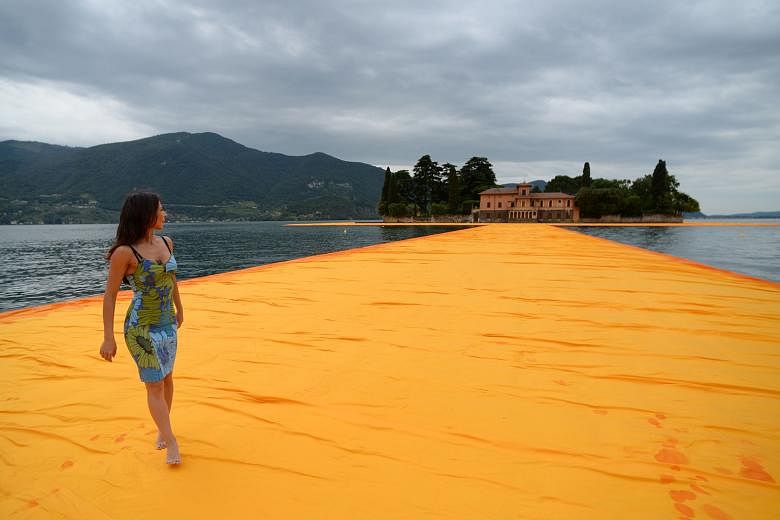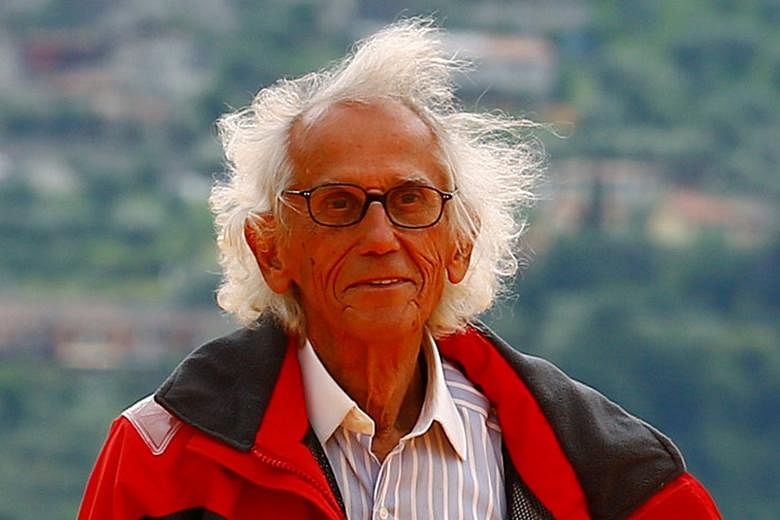PILZONE, ITALY • It was a long-held dream, but finally, this week, artist Christo walked on water.
On Thursday, he tried out his latest project, The Floating Piers, a walkway stretching 3km to connect two small islands in Lake Iseo, in Italy's Lombardy region, to each other and to the mainland.
He walked on the floating walkway of puckered yellow-orange nylon fabric, crafted to change colour according to the time of the day and the weather. On Thursday, it was pockmarked with bright orange blotches left by footsteps treading on the rain-drenched fabric.
"It's actually very painterly, like an abstract painting, but it will change all the time," Christo, a Bulgarian-born American citizen, said of his project.
The Floating Piers is his first outdoor installation since 2005, when he and Jeanne-Claude, his collaborator and wife, who died in 2009, installed 7,500 golden-panelled gates in Central Park in New York. Like his other works, the €15-million (S$22.8- million) project will be funded through the sale of his artworks.
The director of the project, curator Germano Celant, said: "I think this is a record in the history of Christo's special projects because he and the team realised it in 22 months. Normally, it takes decades. So I will say that it's an Italian and American miracle at the same time."
Getting the walkway to undulate and remain affixed to the uneven lake bottom was the feat that has occupied engineers, construction companies, French deep-sea divers and a team of Bulgarian athletes drafted over the past two years.
The walkway is assembled from 220,000 high-density polyethylene cubes that form its 16m-wide spine, covered this week with a waterproof and stain-resistant fabric made by a German company for the project.
From today to July 3, the project will be open and free to the public 24 hours a day, with a legion of boat hands, lifeguards, stewards and information officers standing guard to avert unintentional dips in the lake.
"It's really a physical thing, you need to be there, walking on it, on the streets here. And it's demanding," Christo said.
The route, which laps around the small island of San Paolo, also includes pedestrian areas in the towns of Sulzano, on the mainland, and Peschiera Maraglio, on Monte Isola, an islet rising out of the lake.
The project, he said, "is all this" - the piers, the lake, the mountains, "with the sun, the rain, the wind, it's part of the physicality of the project, you have to live it".
Christo, whose full name is Christo Javacheff, and his wife first envisaged a floating piers project 46 years ago, when they were approached by an Argentine art historian, who suggested the Rio de la Plata basin in South America as a site, but the plans fell through. In 1995, they considered reviving it in Tokyo Bay, Japan, but that project, too, was never realised.
But Christo was determined. Apart from the sporadic protests of labour unions and a national environmental organisation that was worried about the impact on the lake, the Italian project went smoothly after local officials and administrators came on board.
But the concerns about the ability of a small lake community to deal with the avalanche of visitors that the project is expected to draw - an estimated 40,000 people a day, according to officials - appear to have been muted for now by enthusiasm for the project.
Lake Iseo is arguably northern Italy's least famous lake, overshadowed by neighbouring Lake Garda. But hotels and lodging options here and in nearby towns are fully booked for the duration of the run.
"Lake Iseo won't be the same after this event," said Mr Fiorello Turla, mayor of Monte Isola.
At the close of its 16-day period, the walkway will be dismantled and its parts recycled and resold.
"The important part of this project is the temporary part," Christo said. "The work needs to be gone because I do not own the work, no one does. This is why it is free."
NEW YORK TIMES


